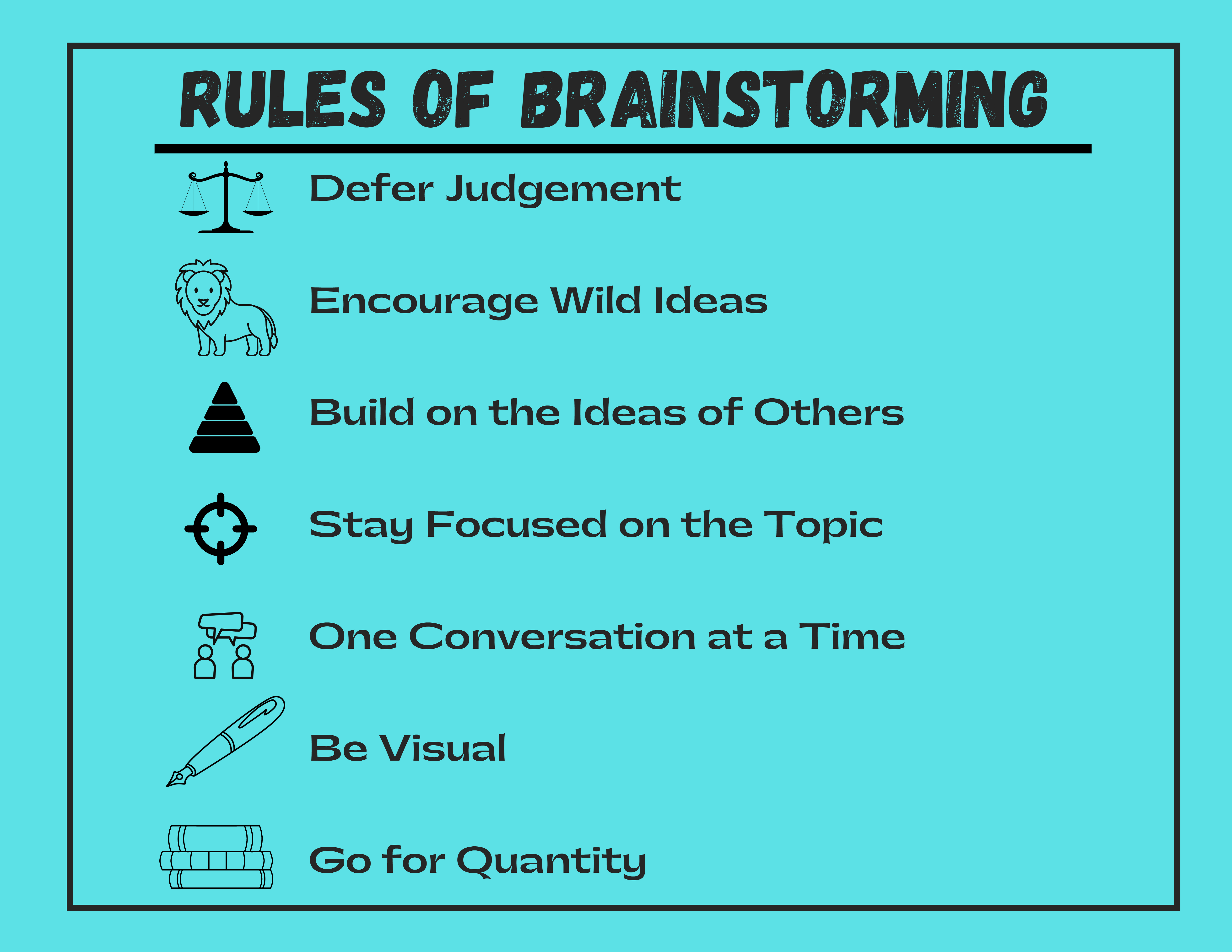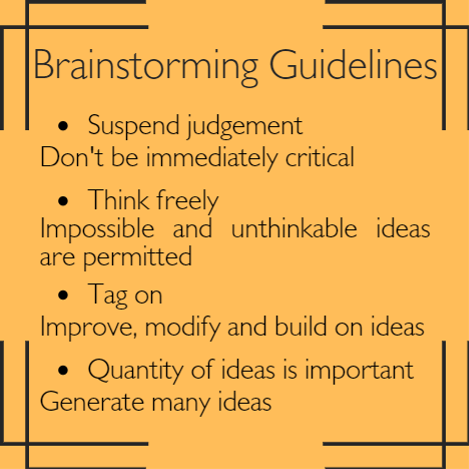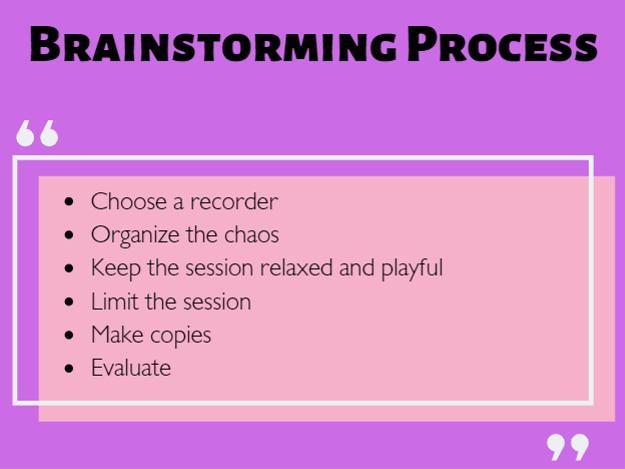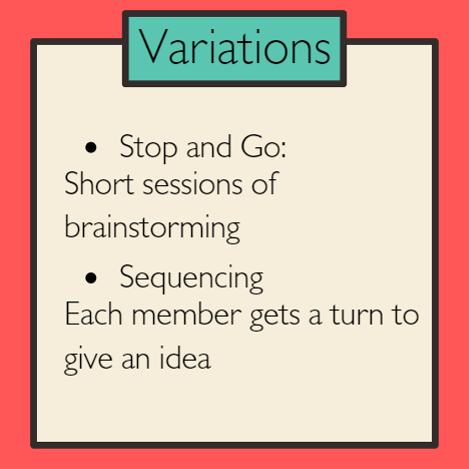Brainstorming is an excellent way of developing many creative solutions to a problem. It works by focusing on a problem and then coming up with very many radical solutions to it. Ideas should deliberately be as broad and odd as possible and should be developed as fast as possible. Brainstorming is a lateral thinking process. It is designed to help you break out of your thinking patterns into new ways of looking at things.

Group Brainstorming
Group brainstorming can be very effective as it uses the experience and creativity of all members of the group. When individual members reach their limit on an idea, another member’s creativity and experience can take the idea to the next stage. Therefore, group brainstorming tends to develop ideas in more depth than individual brainstorming.
Brainstorming in a group can be risky for individuals. Valuable but strange suggestions may appear stupid at first sight. Because of such, you need to chair sessions tightly so that uncreative people do not crush these ideas and leave group members feeling humiliated.
Why Brainstorm
Brainstorming is an idea-generating technique. Its main goals are:
- To break us out of our habit-bound thinking; and
- To produce a set of ideas from which we can choose.
Brainstorming is useful for attacking specific (rather than general) problems and where a collection of good, fresh, new ideas (rather than judgment or decision analysis) are needed.

Brainstorming Guidelines
Suspend judgment: This is the most important rule. When ideas are brought forth, no critical comments are allowed. All ideas are written down. Evaluation is to be reserved for later. We have been trained to be so instantly analytic, practical, and convergent in our thinking that this step is very difficult to observe, but it is crucial. To create and criticize at the same time is like watering and pouring weed killer onto seedlings at the same time.
Think freely: Freewheeling, wild thoughts are fine. Impossible and unthinkable ideas are fine. In fact, in every session, there should be several ideas so bizarre that they make the group laugh. Remember that practical ideas very often come from silly, impractical, impossible ones. By permitting yourself to think outside the boundaries of ordinary, normal thought, brilliant new solutions can arise. Some "wild" ideas turn out to be practical, too.
Tag on: Improve, modify, and build on the ideas of others. What's good about the idea just suggested? How can it be made to work? What changes would make it better or even wilder? This is sometimes called piggybacking, hitchhiking, or ping-ponging. Use another's idea as stimulation for your own improvement or variation. As we noted earlier, changing just one aspect of an unworkable solution can sometimes make it a great solution.
Quantity of ideas is important: Concentrate on generating a large stock of ideas so that later on they can be sifted through. There are two reasons for desiring a large quantity. First, the obvious, usual, stale, unworkable ideas seem to come to mind first, so the first, say, 20 or 25 ideas are probably not going to be fresh and creative. Second, the larger your list of possibilities, the more you will have to choose from, adapt, or combine. Some barnstormers aim for a fixed number, like 50 or 100 ideas before quitting the session.
Brainstorming Process
Click here to view a video that explains Brainstorming techniques.

Choose a recorder: Someone must be put in charge of writing down all the ideas. Preferably, the ideas should be written on a board or butcher-papered walls so that the whole brainstorming group can see them. Lacking this, ideas should be put down on paper. In an ideal session, the recorder should be a non-participant in the brainstorming session, since it's hard to be thoughtful and creative and write down everything at the same time. But in small sessions, the recorder is usually a participant, too.For a one-person brainstorming session, using an idea map on a large piece of paper is useful. Butcher paper on the walls is good, too. Large writing helps keep your ideas in front of you.
Organize the chaos: For groups of more than three or four, have a moderator to choose who will offer an idea next, so that several people don't speak at once. The moderator should prefer those with ideas that tag onto previous ideas, then those with new ideas. If necessary the moderator will also remind members of the group not to inject evaluation into the session (in case a member task, sneers, says, "Oh, come on," and so forth).
Keep the session relaxed and playful: The creative juices flow best when participants are relaxed and enjoying themselves and feeling free to be silly or playful. Eat popcorn or pizza or ice cream or make paper aeroplanes or doodles while you work, even if the problem itself is deadly serious like cancer or child abuse. Don't keep reminding everyone that "this is a serious problem" or "that was a tasteless joke."
As an aid to relaxation and stimulation of the creativity, it is often useful, to begin with, a ten-minute warm-up session, where an imaginary problem is tackled. Thinking about the imaginary problem loosens people up and puts them into a playful mood. Then the real problem at hand can be turned to.
Some imaginary problem topics might include these:
- How to heat a house more efficiently.
- How to light a house with a single light bulb.
- How to improve your travel from home to work.
- Inventing a new game for the Olympics.
- How to improve institutional food without increasing its cost.
Limit the session: A typical session should be limited to about fifteen or twenty minutes. Longer than that tends to become dragging. You should probably not go beyond thirty minutes, though thirty is the "ideal" length.
Make copies: After the session, neaten up the list and make copies for each member of the session. No attempt should be made to put the list in any particular order.
Add and evaluate: The next day (not the same day) the group should meet again. First, ideas thought of since the previous session should be shared (entered on the photocopied lists). Then the group should evaluate each of the ideas and develop the most promising ones for practical application.
During the evaluation session, wild ideas are converted to practical ones or used to suggest realistic solutions. The emphasis is now on analysis and real-world issues. Some brainstormers divide the ideas found to be useful into three lists:
A - Ideas of immediate usefulness: These are the ideas you will be able to use right now.
B - Areas for further exploration: These are ideas that need to be researched, followed up, thought about, and discussed more fully, and so on.
C - New approaches to the problem: These are ideas that suggest new ways of looking at the situation.
Note here that evaluation does not take place on the same day as the brainstorming session. This fact keeps the idea session looser (no fear that evaluation is coming soon) and allows incubation time for more ideas and time for thinking about the ones suggested.
Brainstorming Variations

Stop and Go: For stop-and-go brainstorming, ideas are generated for three to five minutes. Then the group is silent (and thinking) for three to five minutes. Then ideas are given out for another three to five. This pattern alternates for the entire session.
Sequencing: In this technique, the moderator goes in order from one member of the group to the next in turn or sequence. Each member gives whatever ideas he then has, and they are written down. If a member has no ideas, he just says, "Pass," and the next member responds. This movement in turn or around the table continues throughout the session. (Sequencing has been said to nearly double the number of ideas generated in a brainstorming session.)